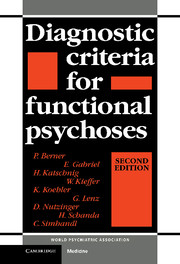B - Schizophrenic psychoses
Published online by Cambridge University Press: 07 September 2010
Summary
This section comprises seventeen diagnostic systems. Eleven of them (B6 to B16) can be qualified as operational criteria; the rest really consist only of directives for classification. The first four of the latter were chosen from the abundance of contributions to diagnosis for schizophrenia – not only because they are still widely used but also because, as mentioned in the Introduction, they represent important stages on the path leading to the development of operational criteria. The depiction of these most important foundations for operational criteria is followed by a discussion of the ICD criteria, which represent an international consensus; the criteria of ICD–10 (with respect to the April 1989 draft for the 10th revision) have been operationalized for research purposes.
After the ICD–10 draft come descriptions of all the other operational criteria, arranged according to their degree of relationship. The St Louis criteria (also called the Feighner criteria throughout this book) and the research diagnostic criteria (RDC) are described first of all, followed by the schizophrenia criteria of the DSM–III, which are derived from the Feighner and RDC system, and its successor, the DSM–III–R. Next comes the New Haven schizophrenia index (NHSI), which represents an operational variation of the DSM–III classification scheme. This is succeeded by two systems based on the present state examination (PSE) method; namely the Carpenter–Strauss–Bartko (CSB) system and the CATEGO criteria. The Vienna criteria, which also make use of the PSE for data-gathering, and the Taylor/Abrams criteria, both of which show close ties in their inception, are treated next.
- Type
- Chapter
- Information
- Diagnostic Criteria for Functional Psychoses , pp. 11 - 12Publisher: Cambridge University PressPrint publication year: 1992

